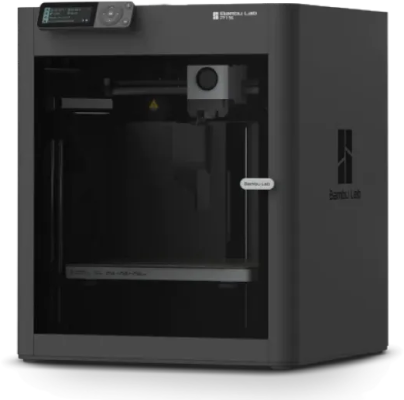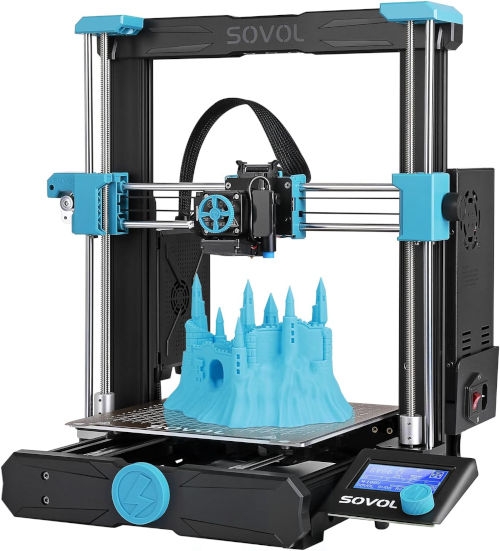Further adventures in 3D printing
Published on

The Bambu Labs P1S.
Not quite a year ago, I bought a Sovol SV06 3D printer and wrote about my initial experiences. At the end I joked:
I’m sure there will be more problems, but hopefully I get at least a week or so before anything else goes wrong. Maybe I’ll print an “X days since the last SV06 problem” counter…
That turned out to be more prophetic than I expected. It became a running joke that I’d flip the imaginary “days since” sign back to 0 almost every time I printed. I still really enjoyed having a printer, though: it’s so useful to be able to be able to go from an idea to a CAD drawing to a physical object in the space of minutes or hours. So when Bambu Labs reduced the price of the P1S — a printer generally regarded as about as trouble free as you can get — to £522 including shipping, I splurged on one.
Concerns
I make it sound like that was an easy decision, but I actually ummed and ahed a lot before pulling the trigger. I had a lot of objections to a Bambu Labs printer, and wasn’t quite sure if the price made up for them.
The Bambu Labs printers are designed to be more consumer friendly than most previous 3D printers. You can start a model printing directly from their website or mobile app, which employs a cloud-based slicer that then sends the model down to your printer. This is one of those things that sounds amazing for consumers, but should terrify anyone who works with computers. There are so many ways for a “cloud-connected” printer to go wrong, and with such potentially disastrous results it gives me anxiety just thinking about it.
This is not just theoretical, either. In a blog post with the rather under-stated title of “Initial Investigation in the Bambu Cloud Temporary Outage”, Bambu describe how a server-side error caused printers to start printing unprompted. Users on Reddit reported printers starting in the middle of the night, trying to print on top of other objects that were left on the build plate, and so on. 3D printers can easily start fires; having them cloud controlled is frankly insane.
As a result of that “temporary outage”, Bambu further improved the “LAN mode” for their printers, which allows you to sever its connection from their servers and control it over the network. That’s basically how my old printer worked anyway, so I was happy enough that I could enable LAN mode and ignore all the cloud nonsense.
My other objection to Bambu was more nebulous. Almost all 3D printers are built upon open source software, and some companies like Prusa go out of their way to make their products more open to give back to the community. Bambu don’t really do any of that: I’d be very surprised if they hadn’t incorporated a bunch of open source software into their printers and just ignored the licences1. I’d much rather give my money to a company doing good, but the only equivalent printer was the Prusa MK4 which was double the price and didn’t come with an enclosure. To add an enclosure kit would have made it £800 more expensive than the P1S, and I just can’t justify that.
Experience
The initial setup of the P1S was a breeze. While the SV06 shipped in parts, the P1S came fully assembled and just needed some packaging and retaining screws removed. These were all clearly marked with large coloured arrows. It’s very much designed so anyone can do it.
I ran through the initial calibration, firmware update, and then put it in LAN mode. Then I just started printing and it went fine. No messing around levelling a bed, or using a sheet of paper to try and set the Z-offset properly; it just worked. It was really loud though. After talking a bit with a friend who’d also bought a P1S, I realised that most of his noise was from the fans, while most of mine was from the servos. A bit of research later and I found out they added servo noise compensation in a firmware update, but I hadn’t run the calibration for it because the initial calibration happened before the update. After doing that, the printer went from sounding like it was impersonating a continental police siren to just being a bit fan-y.
The biggest difference over the SV06 is the speed. I’d swapped the nozzle on the SV06 to a 0.6mm one, and generally printed at a layer height of 0.4mm. The P1S still has its 0.4mm nozzle, and I mostly print at a layer height of 0.2mm. So it’s laying down twice the number of layers, with a nozzle that can extrude half the amount of plastic… And it’s at least twice as fast! Prints that I previously wouldn’t have even attempted on the SV06 are now 8-10 hours on the P1S, without even adjusting the speed or lowering the quality. Here’s a side-by-side comparison:

P1S vs SV06.
The P1S can print eight objects because of its slightly larger bed, while the SV06 can only manage three. The P1S is also printing at a much higher quality. Yet somehow it still ends up being faster. It’s mind blowing.
The other big difference I’ve not mentioned yet is that the P1S is a “core XY” printer rather than a “bed slinger”. That means in order to move along the Y-axis (from the front of the bed to the back), the P1S moves the extruder while the SV06 moves the bed. This makes a big difference when printing tall objects, as they’re far more likely to wobble and come loose when the bed is moving back and forth. It also presumably makes the kinematics a lot easier as the mass of the moving parts is constant, instead of gradually becoming heavier as more and more plastic gets added.
The only failures
I’ve only had a handful of failures since getting the P1S. I had one weird issue where the slicer decided to print some parts extremely slowly, and the print just didn’t work out in those parts; that’s more of a slicer issue, though: after tweaking the model to stop the weird behaviour it printed fine.
The only failure I can directly attribute to the printer was when I tried ironing. This is a process where after printing the top layer, the printer slowly goes back over it at the same height while extruding a small amount of plastic. This is meant to fill in the small gaps between extrusions and give a smooth finish. In my case, though, it just clogged the nozzle and extruder.
At first I thought it was because I was printing too hot: the profile I was using was designed for fast printing, so had to melt the filament rapidly, but there was no way to turn that temperature down just for the ironing pass. I tried another run at a lower temperature and everything clogged again. I then swore off ironing, did a normal print, and everything clogged once more.
At this point I was getting exceedingly good at disassembling the hot end, but also fairly annoyed. It felt like I was using an SV06 again2! I’d previously read some recommendations that you should leave the door or top of the enclosure open when printing PLA, but had never really had any issues so hadn’t bothered. I tried a print with the top propped open and everything worked smoothly again. In hindsight all these clogging issues happened when it was particularly hot and humid outside, which was probably a factor.
Summary
Upgrading to the P1S has made the 3D printer feel more like a tool and less like an additional ongoing project. The speed increase continues to amaze me, as does the increase in quality.
I still think it was valuable to have the SV06 to learn how printers work — you definitely don’t get as much of that from using something so consumer-focused as the P1S — and figure out if I was actually going to use it long-term or whether it was just a fad for me. So it served its purpose, but I’m rather glad to see the back of it in favour of something better in pretty much every way.
-
And if they did there’s nothing anyone can do about it because copyright doesn’t exist in the same way in China. ↩︎
-
Although taking apart the P1S (which is a proprietary machine you might not expect to be very user-servicable) was orders of magnitude easier than taking apart the SV06 (which was an open source design). Everything is just much nicer: the connectors are easier to attach and detach, the screws are all a consistent size instead of needing a whole suite of allen keys, and so on. ↩︎
Thanks for reading!
Have thoughts? Send me an e-mail!
Related posts

Adventures in 3D printing
I’d been idly considering getting a 3D printer for a while, but have only recently taken the plunge. I picked up a Sovol SV06 from Amazon for £199.99, which is a model commonly recommended for beginners. About three weeks later, I think I’ve finally finished fixing all the problems the printer has, and thought I’d document them. Setup and out of the box performance The setup of ...

Project log: Filament weight display
One problem I have when 3D printing is that it’s hard to gauge whether there’s enough filament left on a roll to complete a print. Sometimes it’s obvious when the print is small or the roll is full, but often it’s not. If I’m unsure about it, I end up obsessing over the printer instead of just leaving it to do its thing. The typical approach to this problem is to use ...

Building a travel toolkit
For a while now, whenever I’ve traveled anywhere I’ve dumped a selection of tools into my backpack just in case I need them. Originally this was mostly focused around being able to open and fix my laptop if anything went wrong, but over time has slowly expanded to include other useful tools. Repeatedly packing these tools and then returning them to where they belonged was tedious, thou...
{% figure "right" "Marketing image of the Bambu Labs P1S" %} Not quite a year ago, I bought a Sovol SV06 3D printer and [wrote about](/adventures-in-3d-printing/) my initial experiences. At the end I...